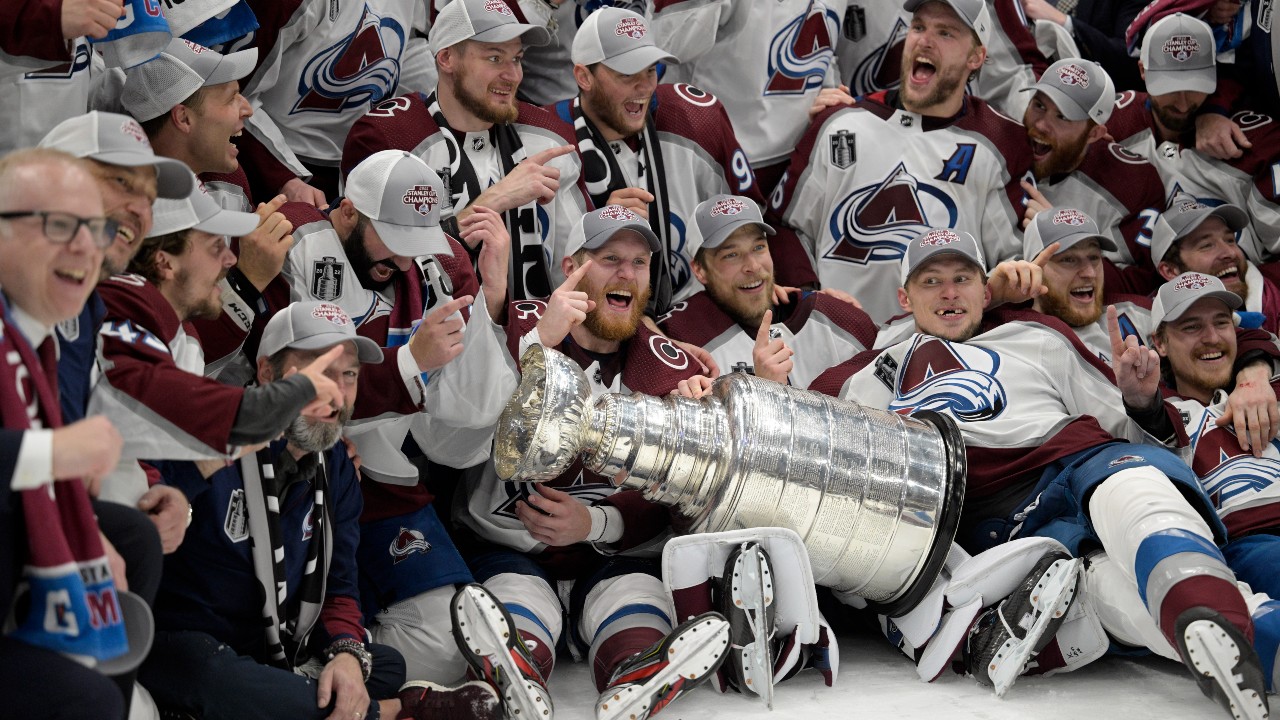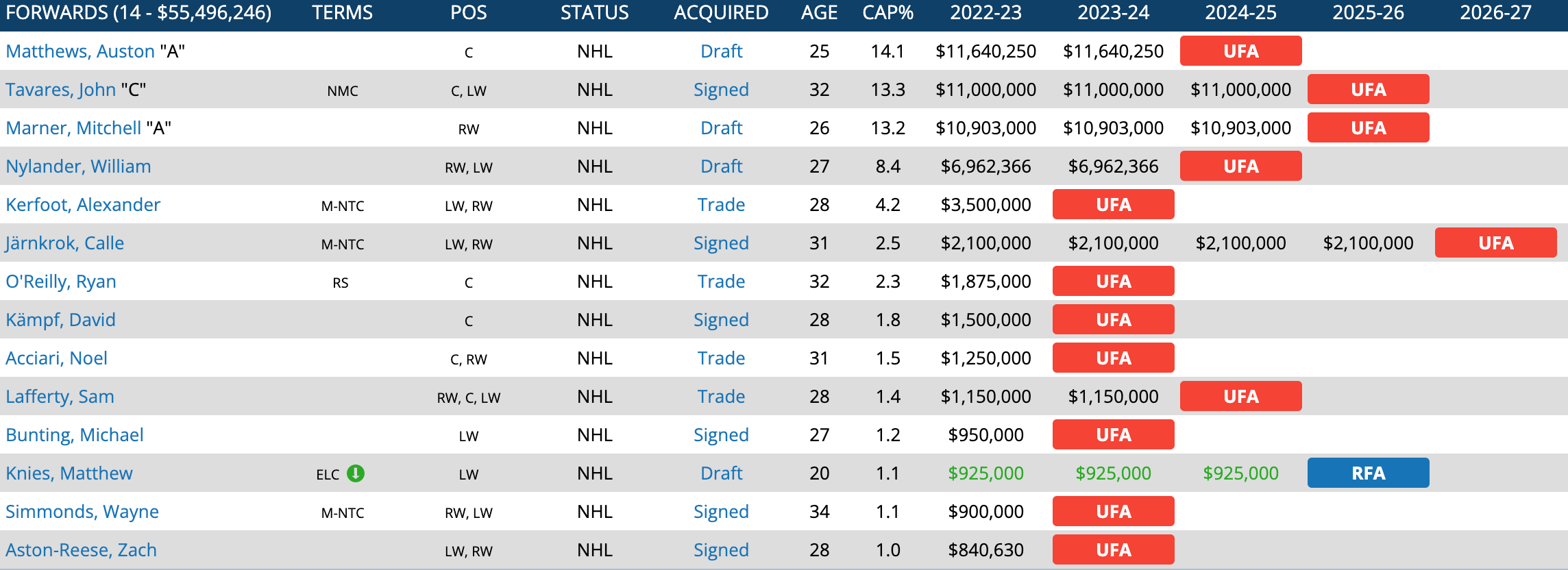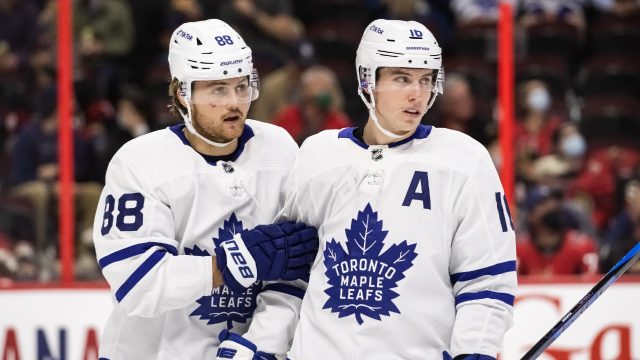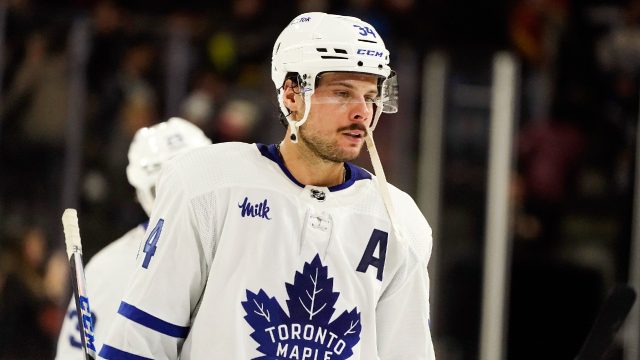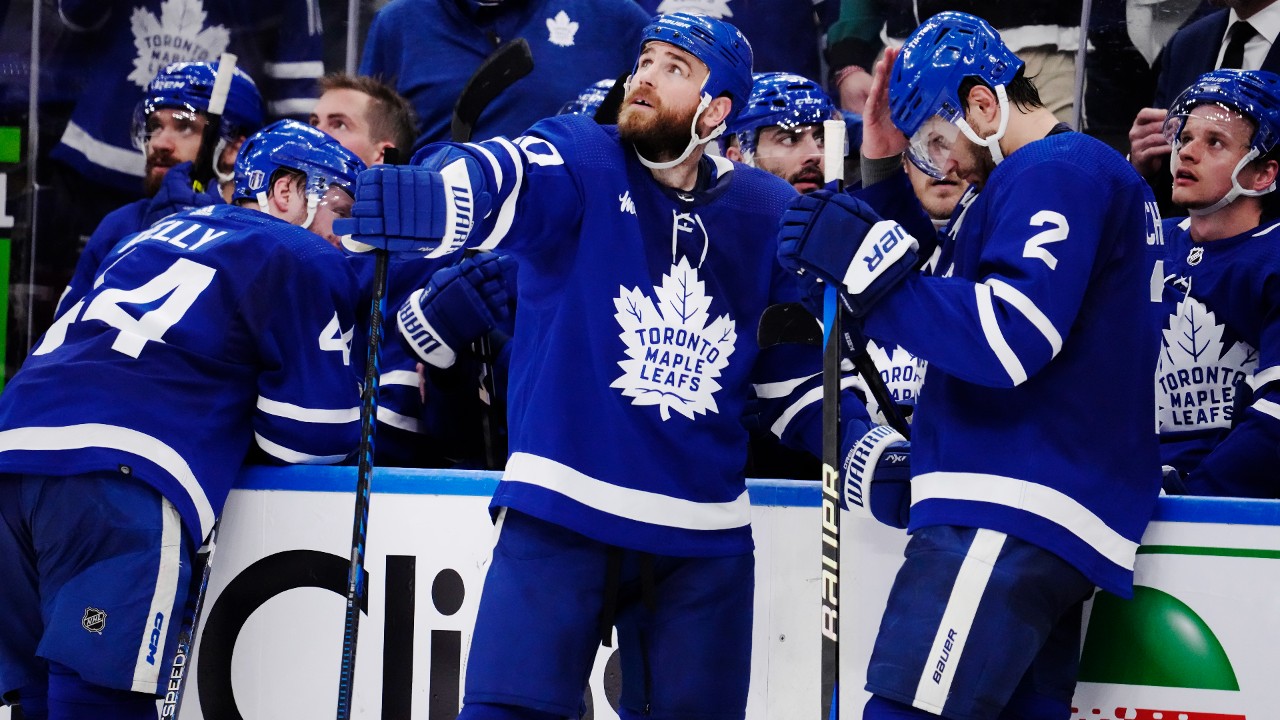
At the end of each season, all NHL teams conduct a thorough review of their entire organization. They start with the NHL roster, analyze the minor league system, take stock of how prospects are developing around the globe, and strategize for the draft and free agency. It’s not a simple process. It takes time, and it’s imperative to take a realistic approach with the project.
In the case of the Toronto Maple Leafs, this year’s off-season evaluation process has more than its share of moving parts.
Note: If you aren’t “into” numbers and stats, feel free to skip directly to player analysis and what recommendations would be at the bottom of this piece, followed by some trade suggestions.
END OF SEASON NHL ROSTER
The first order of business is to evaluate our end of season roster. The GM leads the meeting, with input from his assistant GMs, capologist, analytics department, and scouting staff.
Every team is different, but some teams will divide their rosters into categories:
• Core piece: retain
• Core piece: trade/entertain offers
• Secondary piece: retain
• Secondary piece: trade/entertain offers
• Depth piece: retain
• Depth piece: trade/entertain offers
• Restricted Free Agent: qualify
• RFA: walk
• Unrestricted Free Agent: sign
• UFA: walk
• Goaltending
ITEM NO. 1: SALARY CAP STRUCTURE
With help from our friends at CapFriendly.com, here is a look at the salary breakdown and amount of term each player has remaining on his current deal with the Leafs.
NHL Roster, Forwards
NHL Roster, Defencemen
NHL Roster, Goalies
Long-Term Injured Reserve
CORE PIECE: RETAIN
Auston Matthews: Let’s get this over and done with early. Players like Matthews don’t come along very often. Matthews’ all-round game has improved over the past couple seasons. He’s playing more physical and he blocked 30 per cent more shots, year over year, defensively this past season (92). He won 53 per cent of his draws and led the team with 327 shots on goal. Perspective is required. Matthews scored 40 goals, 45 assists and he was a tidy plus-31 in the regular season.
I’m not letting him off the mat, however. The team needs more from him beyond the first round of the playoffs. He wasn’t good enough in the second round. He didn’t lead the way the group requires him to lead.
With one year left on his contract it’s time to make sure he wants to be a Leaf for another contract cycle. There’s zero chance I go through the entirety of next season without him signed to an extension. I’m not sure what the number is going to look like, but for my taste he falls below Nathan MacKinnon territory ($12.6M AAV) due to the fact he hasn’t proven he can carry the group in the playoffs so far.
Morgan Rielly: Some people will reflect and be critical of his regular season. And they wouldn’t be out of line. He averaged 22 minutes per game of ice time, was deployed in all situations, and finished minus-9. He had some tough nights. But he was the Leafs’ best player in the playoffs (24 minutes TOI in all situations, plus-11). I value his playoff performance more than his regular season by far. He’s on an affordable contract and is the de facto captain of the team in my view.
CORE PIECE: TRADE/ENTERTAIN OFFERS
Mitch Marner: I respect Marner and his ability. He’s an elite offensive talent who plays a reliable defensive game and is a top tier forward in the league. My decision isn’t so much about his statistics. His regular seasons have been fantastic, while his playoffs have been a roller coaster.
Several years ago, when I was a member of the Florida Panthers scouting staff, we interviewed Marner at the draft combine. He was, as expected, a great interview. He spoke about his teammates in London, how much he wanted to win, and how he cared about people in the community. I believe he’s a genuinely good person. When he left the room, however, I recall telling my colleagues there’s something missing in his DNA. I wasn’t sure what it was then, and I’m not sure what it exactly is today. I know that sounds juvenile, but sometimes people just get a feeling about someone or something without being able to put their finger on the exact issue of concern.
In my opinion there’s something holding Marner back from getting over the hump in the Toronto market. He talks about wanting to do it, but also has an edge about him towards the media.
The bottom line for me is that nobody cares when elite athletes making $11 million a year are having to deal with distractions and media. Leaf fans want more and they deserve more from Marner. More importantly, if I’m one of the owners of the franchise and a star player walks into my office demanding the kind of money Marner makes, I’m expecting his maturity to eliminate outside noise and deliver on their end of the bargain when things get hard.
If asked, I’d be recommending moving Marner before his no-move clause kicks in July 1. There’s a hockey trade to be made somewhere in the league.
William Nylander: I’m no different than any other Leaf fan when it comes to Nylander. Some nights he fascinates me with his speed and skill. Other nights I wonder if he’s worried about getting his skates scuffed up in traffic and avoids the hard areas altogether.
I know one thing, the entire Leafs organization wants more consistency from Nylander and they know he is capable of it. I’m not buying the fact his playoffs were better than some of his teammates. He ended the post-season a minus-4 and still tends to shy away from taking the puck to the middle of the ice far too often. He may go on to score 40 goals, or more, elsewhere and I’m okay with that.
I’ve tried to find someone around the same age as Nylander who could score the way he does if they cut the corners that he does. It’s difficult. And I’m not sure this Leafs team can have this core together and get to the next level as a unit.
The closest example I have is Jack Eichel before he was dealt from Buffalo to Vegas. The Sabres, as a team, appear to be tracking more positively after moving their best player, at that time, out of town. (Before everyone gets too worked up with this example, I know Eichel and the Sabres were heading for a divorce due to a multitude of reasons. I’m simply comparing the on-ice value of the player.)
Like Marner, I believe there is a hockey trade to be made involving Nylander. The return might not satisfy everyone on paper, but could start paying off when the games get harder again next April.
John Tavares: I have a ton of respect for the consummate pro that Tavares is. He’s a low maintenance leader who gives all he has. This contract isn’t aging well. I see Tavares on the wing next season, but still taking key face-offs in all three zones when required. He still produces offensively and he’s extremely skilled between the hash marks/outside the crease in the offensive zone. His pace is a massive concern however, thus the need to move to the wing. He also has a full no-move clause in his deal, so realistically Tavares is here to stay. But, he falls into the “trade/entertain offers” category because I would absolutely listen to an offer to take this contract off my hands.
SECONDARY PIECE: RETAIN
There are several players who fit into this category on the Leafs. Here are some “quick hits” on reasons why they’ll remain in Toronto next season:
Matthew Knies: This is an obvious one. Knies is just getting started. A year from now he will likely have established himself as part of the core forwards, but he finds himself in the second tier of this year’s roster due to his late arrival. It was incredible to me how much of a void the Leafs had in their lineup when he went down with a concussion versus Florida. Knies came as advertised and he will score more in time. It was positive to see how he established himself as a tenacious competitor who battles along the wall and crease.
Calle Jarnkrok: He caught lightning in a bottle – or found situational success – whichever you choose. He benefited from playing alongside some of the Leafs’ top six scoring forwards and surprised me by scoring 20 goals in regular season. His playoffs were well below the standard he had set, but let’s not get mislead. Jarnkrok is a 3F, not a 2F or 1F. He’s a middle-of-the-lineup forward who can skate around 15 minutes per night, slide on to the second power-play unit and kill penalties. His salary is affordable for his role ($2.1M AAV).
Jake McCabe: I like McCabe’s salary ($2M AAV) and his competitiveness. The Leafs added grit to their lineup when they acquired McCabe and Luke Schenn around the trade deadline, but McCabe’s playoffs were erratic. He needs to settle down, at times, and let the game come to him instead of chasing a hit or jumping offensively at the wrong time. I think McCabe is a player who can play as a fourth or fifth defenceman. He isn’t the pure shutdown defender the Leafs used him as in the playoffs and his minus-7 rating speaks to that.
Conor Timmins: I’m good with having Timmins as an option next season because he was steady in the regular season when he got a chance. He’s a coveted right shot defenceman who’s only 24 years old and scored two goals and 12 assists in 25 games with the Leafs. He should battle for a job on the bottom pairing, with the potential to eventually trend upwards. Timmins is efficient when deployed on the second power-play unit as well. One thing the Leafs don’t get with Timmins is much physical push back. He averaged less than one hit per game, and less blocking shots. The key to his maturity will lie in his durability. Timmins has had his share of injuries dating back to his junior days with the Soo Greyhounds.
Mark Giordano: His regular season was solid, but the wheels fell of when the games got quicker and faster in the playoffs. Nonetheless, Giordano is the kind of veteran player who can be used as a depth piece next season and his leadership is valuable as well. At this point of his career, he’s almost a playing assistant coach. Hopefully fewer regular season minutes will lead to him having more legs come playoffs next spring. He’s on a team friendly contract paying $800,000 for one more year and he’s worth that money to the group as a whole – including coaches and management.
Note: Giordano averaged 19 minutes of ice time in the regular season, was used primarily at even strength and the penalty kill and blocked 147 shots.
T.J. Brodie: I have to admit I struggled breaking down Brodie’s game and where it is trending heading into next season. Ultimately it came down to the fact that, although his playoff performance lacked detail at times, his body of work for the entire season gives me hope he can still be a useful player in 2023-24. I wish he was making less money, but the reality is that it’s not easy to find someone like Brodie who’s making less than $5 million for one more year. Brodie finished plus-10 in the regular season, averaged over 21 minutes of ice at even strength and on the penalty kill, and blocked 111 shots. His contract is also armed with a 10-team no-trade list for next season, coming off a full no-move clause he previously had.
SECONDARY PIECE: TRADE/ENTERTAIN OFFERS
Timothy Liljegren: This one comes down to me observing how the organization values Liljegren as much as how I forecast his value to the group moving forward. I’m not sure Liljegren can do anything more to earn the trust of the Leafs brass. He had a nice regular season and averaged 18 minutes of ice time when in the lineup. But come playoff time he found himself in “no man’s land” as a bit of an extra/sort of being relied upon.
The bottom line, for me, is I believe there is a market for his services next season somewhere in the league. He’s affordable ($1.4M AAV), he skates well, and he’s proven he can be relied upon to kill penalties. I can’t wrap my mind around trusting Liljegren to make the right play at the hardest time of the season, though. He finds a way to turn a puck over, or join the rush at the most inopportune times, and the puck usually ends up in the back of the Leafs’ net as a result.
DEPTH PIECE: RETAIN
Sam Lafferty: A depth energy provider who can play all three forward positions. He showed he can play fast, chip in offensively occasionally, and compete up and down the ice. He wasn’t used in any special teams roles and averaged just over 10 minutes of ice time per game. He is what he is and his salary is affordable ($1.15 M).
UNRESTRICTED FREE AGENTS: SIGN
I have to qualify these recommendations with the reality that every scenario will come down to what the player believes he’s worth at this stage in his career. Some will likely price themselves out of the running for the Leafs, while others might accept the same dollar amount for an extra year of term.
Noel Acciari: Trustworthy and he plays to a consistent identity. A physical depth forward who always competes and makes life hard on opponents. I would offer a two-year extension that carries and AAV of $1.3M.
Luke Schenn: How can the Leafs not want Schenn back? He delivered. Schenn played to his strengths the entire season, logging 26 games for Toronto and administering 114 hits over that span. My concern is obvious: when does the end of the line quickly appear for Schenn? Until that time arrives, I would offer him a one-year extension at a reasonable salary — $1.25M — knowing he might counter with $1.5M.
Ryan O’Reilly: My gut tells me he will be too expensive for Toronto, but you never know until you engage in discussions. O’Reilly is a reliable leader who can still produce secondary offence, win key face-offs, and be used in all situations. I don’t, however, believe he has the legs to log 20 minutes per night. If the shoe fits, get him signed. This one will come down to salary expectation in relation to term. As I write this, I can’t say for certain what the market will offer O’Reilly come July 1. Time will tell.
UNRESTRICTED FREE AGENTS: WALK
Without turning this into a deep dive on every one of these names, I would recommend moving on from the following UFAs:
• Alex Kerfoot
• David Kampf
• Michael Bunting
• Wayne Simmonds
• Zach Aston-Reese
• Justin Holl
• Erik Gustafsson
GOALTENDING
Ilya Samsonov: Samsonov is a restricted free agent with arbitration rights and his qualifying offer is $1.8M. He’s getting a raise. What that raise looks like will take some time to work itself out, but he proved he is capable of competing for the net and had a solid season (42 GP, 2.33 GAA, .919 SV%).
I’m not 100 per cent sold on Samsonov as a goalie who can play 60 games as a starter and take a team deep in the playoffs. I do believe he is a capable 1A, so the salary and term of his next deal have to make sense on that level. A comparable for me would be Alexandar Georgiev (Colorado) who is making $3.4M (AAV).
Matt Murray: I can’t wrap my mind around Murray coming back to the Leafs and contributing for a full season without injury. This contract has buyout written all over it for me, especially since Murray is due to make $8M in actual cash.
This is what buying out Murray’s contract would look like against the Leafs’ salary cap and the recapture hit Ottawa would incur.
Joseph Woll: Technically Woll wouldn’t usually be part of the NHL roster year-end evaluation, but let’s be honest: He provided a small sample size of what he can provide moving forward and I expect him to compete for a significant number of games next season. His contract scenario is fantastic as well with a $766,667 AAV through 2024-25.
HOMEGROWN TALENT AND POTENTIAL
• For as long as I’ve been scouting Nick Robertson, he has had nothing but bad luck when it comes to injury. I recognize the organization still believes he has a spot to earn come September – and maybe he will – but I’m not buying high on his stock at this point in time.
• Bobby McMann had a cup of coffee with the big team this year and showed he is capable, at worst, of providing middle-six/depth minutes. McMann is a forward who plays a competitive game and has the ability to find pucks around the crease. I expect him to compete for a roster spot next season.
• Alex Steeves is also a likeable prospect who put up solid numbers in the AHL with the Marlies (19 goals, 32 assists). He caught my eye at training camp last fall. He plays with pace and has projectable skill that could provide some secondary NHL scoring.
• Topi Niemela will need more time in the AHL before being pushed into full-time NHL duty. He came over to North America at the end of this season and by all accounts adapted nicely. Niemela isn’t elite offensively, but he’s very smart with the puck on his stick. He outlets very well. Defensively, he isn’t going to punish anyone physically in the NHL but he’s a calculating “area” defender who has sound read/react awareness in his zone.
TRADE CALLS
The Florida Panthers acquired Matthew Tkachuk from the Calgary Flames last summer in a trade that sent Jonathan Huberdeau, Mackenzie Weegar, Cole Schwindt and a first-round pick to the Flames. The deal has become the most talked about example of what can, possibly, be accomplished when dealing core players.
What people have to recognize is the fact the Panthers received a call from the Flames letting them know Tkachuk was available and Florida was one of his preferred destinations. Essentially, the Flames simply told the Panthers if they were interested to put together a package to consider.
In the case of the Leafs, I am assuming Toronto has let teams know they are open to taking calls on certain players. The fact the Leafs’ hockey operations department is currently in flux muddies the water and slows the process, but these are transactions that will take time whether it’s Kyle Dubas or another leader in the GM’s chair making the decision.
The reason I am positioning things the way I am is because the Leafs will be relinquishing a degree of control in any trade discussion. Sure, they have high end players who could be available, but they aren’t in control of what the offer(s) will be on the other end.
HYPOTHETICAL RETURNS
Putting me on the spot, here are some hypotheticals that come to mind:
Toronto trades to Arizona: William Nylander, Timothy Liljegren
Arizona trades to Toronto: Lawson Crouse, Barrett Hayton, 2023 second-rounder
or
Toronto trades to Philadelphia: Mitch Marner, Timothy Liljegren
Philadelphia trades to Toronto: Travis Konecny, Ivan Provorov, 2025 first-rounder, 2023 fourth-rounder
Ryan Dixon will have more “fake trades” for the Leafs on Friday.


